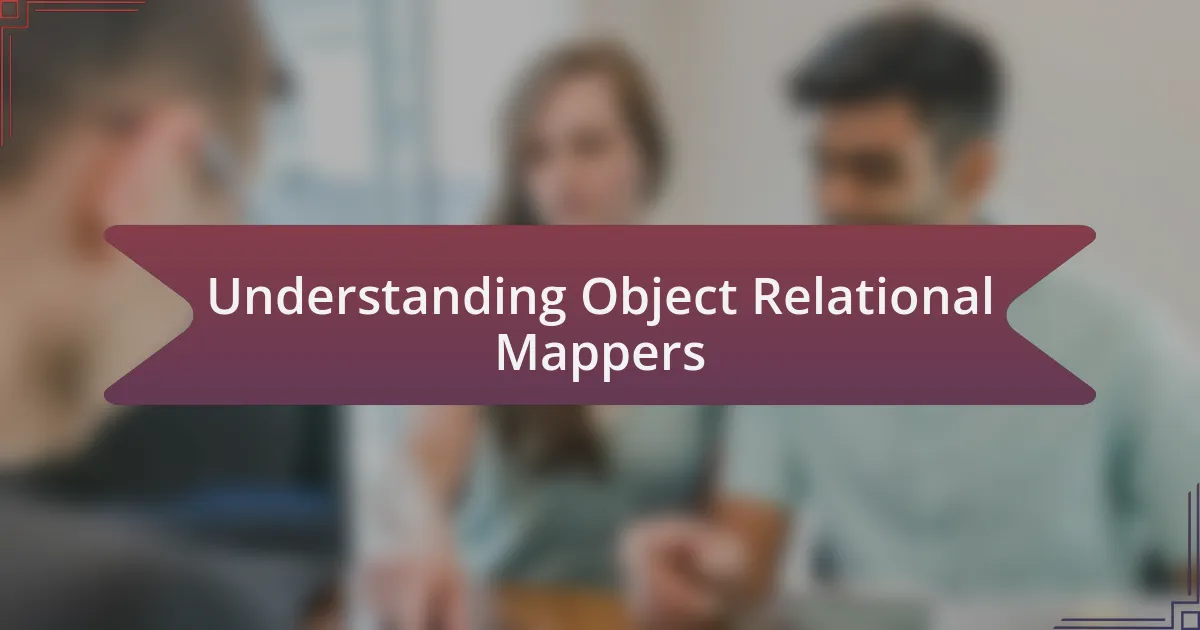Key takeaways:
- ORMs serve as a bridge between object-oriented programming and relational databases, simplifying data manipulation and enhancing developer productivity.
- While ORMs improve code readability and allow for database independence, they can introduce performance issues and complications in debugging if not understood well.
- Best practices for using ORMs include reviewing generated SQL queries, utilizing parameterization for security, and maintaining a solid understanding of the underlying database.

Understanding Object Relational Mappers
Object Relational Mappers (ORMs) serve as an essential bridge between object-oriented programming and relational databases. I remember my first encounter with an ORM; it was like discovering a shortcut that cut away the tedious, repetitive tasks associated with database management. At that moment, I wondered how I had ever managed without it, especially as it transformed my workflow from complex SQL queries to simple, intuitive code.
These tools allow developers to interact with databases using high-level programming languages, making it easier to manipulate data without needing to dive deep into SQL syntax. It’s fascinating how an ORM abstracts the underlying database structure, allowing me to think in terms of objects and classes rather than tables and rows. Have you ever felt overwhelmed by writing hundreds of lines of SQL? I certainly have, and that’s where the beauty of ORMs shines brightly.
While ORMs can significantly improve productivity, they can also introduce some pitfalls if not used wisely. For instance, I recall a project where I relied too heavily on an ORM’s features without really understanding the underlying database operations. It led to performance issues that could have been avoided with a bit more insight. It’s a reminder that, while ORMs simplify many tasks, having a solid grasp of the underlying concepts can really empower you as a developer.

Benefits of Using ORMs
Using ORMs can dramatically accelerate development time. I remember working on a project where the tight deadlines made it crucial to get features up and running quickly. Thanks to the ORM, I could set up data models in a fraction of the time it would have taken to write the equivalent SQL statements. Have you ever wished you could focus on feature development instead of wrestling with complex queries? That’s one of the invaluable benefits I found with ORMs—they let developers channel their efforts toward building great user experiences.
Another significant advantage of ORMs is the increased code readability they provide. When I switched to using ORMs, my codebase became much cleaner and easier to understand. I found it far simpler to revisit projects after some time away, as the object-oriented syntax helped me recall the data structures and relationships instantly. It’s amazing how much easier collaborating with teammates becomes when everyone can grasp the code at a glance.
Moreover, ORMs promote database independence, which I believe is a game-changer. In one of my earlier projects, we decided to switch from MySQL to PostgreSQL. Thanks to our ORM, the majority of the changes required were minimal and primarily involved configuration updates. Have you ever faced the dread of a significant database migration? With an ORM, those fears can be substantially reduced, allowing developers to adapt without extensive rewrites.

Common ORM Tools and Frameworks
When it comes to popular ORM tools, Entity Framework stands out for .NET developers. I remember first diving into this framework, and I was taken aback by how seamlessly I could integrate data access with my C# applications. The strong typing and LINQ support made it feel natural, almost like the framework was anticipating my needs. Have you ever experienced that “aha!” moment when a tool just clicks?
Another strong contender is Hibernate, which is widely embraced in the Java community. I had my share of challenges working with Hibernate’s configurations at first. Yet, once I mastered its various mapping techniques, I found a flexibility that few other ORMs offered. Isn’t it satisfying when you finally unlock the full potential of a tool?
For Node.js developers, Sequelize comes highly recommended. I vividly recall the relief I felt when I transitioned to Sequelize from raw SQL queries. No longer did I have to juggle multiple lines of syntax; instead, I could focus on building features while enjoying straightforward model definitions. Does anyone else find joy in simplifying the intricate complexities of back-end development?

Challenges with ORMs in Development
While ORMs simplify data access, they can introduce unexpected performance issues, particularly when handling large data sets. I found myself frustrated once when a query that seemed efficient ended up generating several SQL statements behind the scenes, leading to significant slowdowns. Have you ever encountered a situation where an ORM’s convenience backfired, making you question its true value?
Debugging with ORMs can also be a bit of a maze. I remember spending hours trying to understand the precise SQL generated by my ORM because the error messages were less than clear. This added layer of abstraction can be a double-edged sword—while it enhances productivity, it often obscures crucial underlying processes. Does anyone else feel that debugging can sometimes feel like trying to untangle a knot in a thread?
Another challenge I’ve faced is the steep learning curve associated with ORM configuration and its rich features. For instance, the way relationships are mapped can be cumbersome, leading to nuances that are easily overlooked. I’ve spent countless nights wrestling with cascading deletes and eager versus lazy loading. Isn’t it ironic how tools designed to ease our workflow can, at times, turn into a puzzle we never wanted to solve?

My Experience with ORMs
When I first started using ORMs, I was impressed by how they abstracted database interactions. However, I quickly learned that this convenience sometimes came at a cost. There was a project where I needed to optimize a feature, and after some digging, I discovered that the ORM generated queries I never anticipated. Have you ever had one of those moments where you wished you could just peek behind the curtain?
Another aspect I found intriguing yet frustrating was the way ORMs handled relationships. I remember a time when I thought I’d nailed down the mapping for a complex many-to-many relationship, only to find out during testing that it didn’t quite behave as expected. It was a classic “back to the drawing board” moment that made me appreciate the precision required in this abstraction layer. Have you faced similar scenarios where your confidence was tested due to ORM behavior?
Over time, I’ve developed a more nuanced perspective on ORMs. While they’ve certainly streamlined many processes, I learned to remain vigilant about performance implications. One particular instance stands out: after a few months of development, I had to refactor a major component due to unforeseen data access delays. It was a real wake-up call that reminded me to balance convenience with caution. How do you ensure you’re not trading efficiency for simplicity in your projects?

Best Practices for Using ORMs
When working with ORMs, one habit I’ve cultivated is to always review the generated SQL queries. I recall a time when I overlooked this step. The ORM produced a query that created a significant bottleneck in performance. After realizing this mistake, I began incorporating query logging into my workflow, allowing me to spot inefficiencies early. Have you ever wished you could have a clearer view of what’s happening under the hood?
Parameterization is another best practice I’ve embraced wholeheartedly. Initially, I relied on the ORM’s default handling for variables, only to run into issues with scalability and security. This became apparent during a project where prepared statements significantly improved our application’s robustness against SQL injection. Have you ever considered how much more secure your application could be just by tweaking a few settings?
Finally, I cannot stress enough the importance of understanding the underlying database. Early in my journey with ORMs, I sometimes assumed the abstraction meant I didn’t need to delve into database-specific features. That was until I hit a complex aggregation problem that only native SQL could solve effectively. This realization changed my approach—I learned that a solid grasp of the database intricacies enhances the way we utilize ORMs. How often do you dive into the database side of things even when using an ORM?